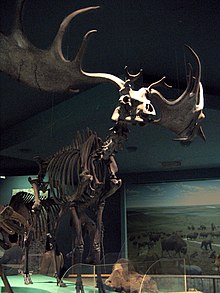Megaloceros
| Megaloceros Temporal range: Late Pliocene to Late Pleistocene,
| |
|---|---|

| |
| Restoration of various Megaloceros and Praemegaceros species | |
| Scientific classification | |
| Domain: | Eukaryota |
| Kingdom: | Animalia |
| Phylum: | Chordata |
| Class: | Mammalia |
| Order: | Artiodactyla |
| Family: | Cervidae |
| Subfamily: | Cervinae |
| Tribe: | Cervini |
| Genus: | †Megaloceros |
| Species | |
| |
| Synonyms | |
|
Megaceros | |
Megaloceros (from Greek: μεγαλος, megalos + κερας, keras, literally "Great Horn"; see also Lister [1987]) is an extinct genus of deer whose members lived throughout Eurasia from the late Pliocene to the Late Pleistocene and were important herbivores during the Ice Ages. The largest species, Megaloceros giganteus, vernacularly known as the "Irish Elk" or "Giant elk", is also the best known.
Most members of the genus were extremely large animals that favoured meadows or open woodlands, with most species averaging slightly below 2 metres at the withers. The various species of the Cretan genus Candiacervus – the smallest of which, C. rhopalophorus was just 65 cm high at the shoulder – are sometimes included in Megaloceros as a subgenus.

Despite its name, the Irish Elk was not related to the elk or wapiti but instead is closely related to the fallow deer genus Dama, and the genus was part of a Late Neogene Eurasian radiation of fallow deer relatives of which today only 2 taxa remain.(Lister et al. 2005, Hughes et al. 2006).
Although sometimes synonymized with Megaloceros, Praemegaceros and Megaceroides are apparently generically distinct.[1]
Species in chronological sequence
- M. stavropolensis
- Early Pleistocene species from Southwestern Russia.[2]
- M. luochuanensis
- Early to Mid-Pleistocene species in the Shaanxi Loess of China.
- M. antecedens
- Very similar to M. giganteus, to the point where it is often regarded as a paleosubspecies of the latter. The antlers were more compact, and the tines near the base large and palmate. Lived in Mid-Pleistocene Germany.
- M. pachyosteus
- Mid-Pleistocene China and Japan. Had long, curved antlers.
- M. savini
- Mid-Pleistocene species, slightly larger than a caribou, first fossils found near Sainte Savine, France. Its antlers were straight, with thorn-like prongs. The lowermost prongs near the base were palmate.
- M. giganteus
- Largest, best known, and among the last species of the genus, about 2 m (6.6 ft) at the shoulders. Lived throughout Eurasia, from Ireland to China during the last Ice Age.
References
- ^ CROITOR, R., 2006. Taxonomy and systematics of large-sized deer of the genus Praemegaceros Portis, 1920 (Cervidae, Mammalia). In: R. D. Kahlke, L. C. Maul, P. P. A. Mazza (Eds.): Late Neogene and Quaternary biodiversity and evolution: Regional developments and interregional correlations. Volume I. Courrier Forsch.-Institut Senckenberg, 256, 91-116.
- ^ http://elibrary.ru/item.asp?id=25069525
Further reading
- Hughes, Sandrine; Hayden, Thomas J.; Douady, Christophe J.; Tougard, Christelle; Germonpré, Mietje; Stuart, Anthony; Lbova, Lyudmila; Carden, Ruth F.; Hänni, Catherine; Say, Ludovic (2006): Molecular phylogeny of the extinct giant deer, Megaloceros giganteus. Molecular Phylogenetics and Evolution 40(1): 285–291. doi:10.1016/j.ympev.2006.02.004 PDF fulltext. Supplementary data 1, DOC fulltext Supplementary data 2, DOC fulltext Supplementary data 3, DOC fulltext
- Lister, A.M. (1987): Megaceros or Megaloceros? The nomenclature of the giant deer. Quaternary Newsletter 52: 14–16.
- Lister, A.M.; Edwards, C.J.; Nock, D.A.; Bunce, M.; van Pijlen, I.A.; Bradley, D.G.; Thomas, M.G. & Barnes, I. (2005): The phylogenetic position of the 'giant deer' Megaloceros giganteus. Nature PMID 16148942 doi:10.1038/nature04134 PDF fulltext Supplementary information
